I was fortunate to become good friends with Christopher Chippendale while we studied with George Nick during our undergraduate years at Mass Art back in the mid-80’s. Christopher and I also both went through the same graduate degree program at Boston University, however not at the same time. We continue to keep in touch and it has been a great pleasure to compare notes and observe the paths both our works have taken over the years.
Christopher Chippendale is represented by Soprafina Gallery, Boston and has been a member of the Painting faculty at Mass Art for twenty-two years. In addition to his work as an artist, Chippendale has been the recipient of numerous grants and awards, published critical essays on art, curated and juried many exhibitions.
The Soprafina gallery will have a solo exhibition of Christopher’s new work in November of this year and he will teach a summer landscape painting workshop this July at the ART New England summer program.
I am grateful to Christopher for putting the considerable time and effort into such thoughtful and articulate writings in response to my questions.
Larry Groff: What led you to decide to become a painter?
Christopher Chippendale: In the summer of ‘74, my brother, who had himself studied painting before becoming a photographer, wanted to stage and then photograph a tableau vivant based on Manet’s Le dejeuner sur l’herbe. At the time, we were living at a place called Wood’s Ranch—a sprawling, ranch-style rambler on an old estate, surrounded by magnolias and lemon groves at the foot of the San Gabriel Mountains in southern California. For the tableau, it was decided that I would take the part of the young gallant who, in Manet’s painting, reclines on one arm while gesturing casually with the other. My brother took the role of the second dandy, seated in the “picnic” center, whilst my then girlfriend sat for the female nude to the left, looking out at the viewer. Atop her discarded habillements, we arranged the same objects as seen in the foreground left of Manet’s Le dejeuner: a picnic basket, some fruit (they appear to be lemons), a hat (we apparently had no bonnet). An over-grown thicket of scrub and lemon trees served as our Bois de Boulogne. My brother set the camera on delayed timer, jumped into his pose and, with the click of the shutter, our playful re-enactment of Manet’s once-scandalous painting joined us to it—in California fashion—forever.
In the following months, a couple dozen prints of our mise-en-scene were produced in the darkroom and, that December, reflecting the wittiness of my brother’s conceit, we sent these out to friends as our Christmas greetings. Ten years later, when I enrolled in art school in Massachusetts to study painting, I came finally to realize the vocation that had been eluding me. Becoming a painter was the first vocational decision I had made in my life with absolute certainty and resolve. Like any momentous decision, it reframed the significance of events that preceded it, making them clearer and necessary, in this case fitting them into the larger narrative of my becoming a painter. Even minor events like our staging of Manet’s painting—which now took on an affectionately prophetic significance—looked fateful in light of my painting decision.
A few years earlier, when I was seventeen, I set out hitchhiking from my home town in California with a vague notion that I was “going abroad.” Nine months later I was in Afghanistan. I had wandered, alone and without an itinerary, through much of Europe, into Turkey and across the Black Sea to Iran, to Herat and as far east as Kabul. I have always been a wanderer, much more drawn to voyaging than to destinations. The openness of setting out with only marginally described objectives engages me still, as a painter, and it informs my work. I do not know the destinations of my paintings. I seek my subjects in the work itself. Like Cezanne, I seek in painting (“Je cherche en peignant”).
I returned to California from Europe and Central Asia and lived for five years in a remote cabin, high in a mountain canyon in the Angeles National Forest. This was my return to, and embrace of, the idea of living a “natural life.” It was also a retreat from the world such as I’d experienced it during my travels abroad, and a place for me to reflect upon them. I read literature and philosophy, wrote poetry, took long hikes, played music, drew and painted, swam daily in the stream outside my cabin door, communed with friends, and worked building trails and fighting fires for the National Forest Service. During one interlude from this period of my life I posed, with my brother and girlfriend, for the aforementioned Le dejeuner.
Looked at in one way, this was a paradisiacal episode of my life. I came eventually to see in it, however, an untenable future. I realized that I needed to be in the world, which I knew little about. I had grown less ambivalent about the value of a formal education, and was drawn to the history I had experienced in my travels, and in the literature and philosophy I read. I decided to move across the country to New England to go to college.
College was in many ways an extension in formal terms of what I had begun on my own already. I majored in French and French literature, writing my thesis on the idea of consciousness in Proust. As part of my program, I went to study in Paris. There, I took a cheap garret room in a five-story walk-up in the 6th arrondissement, and enrolled in French language classes. My interests, however, were in the life and culture around me. I would often cut classes and, as if this prefigured what lay in my future, spend my days wandering around the city, drawing and going to museums. In my daydreams I imagined myself returning to Paris to study painting at the Ecole des Beaux Arts.
Some weeks before my scheduled return to the U.S., I ran out of money. With no prospects of formal employment, I spent my last twenty-five francs on a book of early English ballads transcribed for alto recorder, and I descended into the metro. I busked there, two hours each day, for pocket money and to pay my hotel bill, changing venues daily to avoid harassment from the local gendarmes. To hold up my sheet music while I played, I used a collapsible stand which I fabricated, ironically enough, from the legs of a broken French easel I had found on the street one night.
You ask what led me to decide to become a painter. I think I was always predisposed to become a painter, but it took some important side-roads and divagations along the way for me to discover the rightness of that decision.
Larry Groff: You studied with George Nick, who has been a leading figure and advocate of painting from observation. What can you remember about his teaching that has been most influential for you?
Christopher Chippendale: On a practical level, Nick instilled in me the core conceptual and foundational tools that would continue to serve as a cornerstone of my painting to the present day. On a personal level, his way of thinking about painting helped orient me to a more outwardly focused, concrete way of looking at and being in the world. His was an existential influence and, therefore, for me, an influence of the most crucial kind—one that began with, and was ever refocusing my wandering attention to, the facts of the observable world directly in front of me.
Nick urged me to adopt a clear, that is to say, presuppositionless view of whatever I painted. I was not to presuppose anything in addition to what was actually given. Emphasis in his studio was upon immediate perception, upon what was there, before us, and upon seeing it as such, without past and without future. Nick wanted his students to make an effort, in a deliberate way, to cancel or put aside the normal habits and assumptions with which they approached the world in their everyday understanding. Our charge was to take visual sensations simply as they presented themselves, and only within the limits in which they did so.
To accomplish this required, besides an undistracted Zen-like focus upon the immediate world before us, an examination of the processes by which we, as individual painters, saw the world and transcribed it. Our outwardly focused concentration upon the given had also an inward, requisite component—call it self-examination—through which we should aim to discover how our conceptions of things colored, like tinted glasses, what we saw within the motif. Thought itself, in other words, had the power to transform the visible. One of my duties as an observational painter, I learned, was to understand the manner and mechanisms by which my own individual conceptions of things, whatever their origins, acted upon and informed my perceptions. As Nick’s own teacher, Edwin Dickinson, put in a phrase reflecting the richness of his own circumspection: “The seen distortion is what a thought did to the sight.”
Nick guided us like a courtroom lawyer to question the veracity of what we saw, as evidenced on our canvases, and to question how our conceptions of things distorted how we saw them. Observational painting, I learned, was geared towards something much more essential and original than representing the motif. In my best work I didn’t presume to know what the motif was. Painting, as Nick taught it, was oriented away from the known world, towards the phenomenal one, away from our conceptions of things and towards things themselves. Painting did not serve a mediating role—it served an investigative one. Its function was not to express the predetermined, but to determine, in fact, what was, and to express that directly in ways that only painting could, and as accurately as possible.
Nick’s approach to observational painting reflected a defining 20th century philosophy, existential in nature, and committed to the truth of the unmediated. “Not ideas about the thing but the thing itself,” as Wallace Stevens put it, in a late, great poem of his by that title. It was a philosophy with which I resonated. I found in painting, moreover, a means to express it. I found there a palpability, a physical process that clarified for me a need to locate and express my experience of the world in concrete terms, which is to say, in things themselves.
Observational painting, I learned, was not a mimetic art form. We were not in the business of copying or duplicating what was before us, but of transposing it through paint, and through the forms we each adopted as individual painters. Our goal was not to match or try to outdo what nature did best, but to interpret it through metaphors that were “parallel” and in every way “true” to the facts we perceived, except in being literal about them. Ideas of “truth” in observational painting were, accordingly, not limited to ideas of “likeness” or verisimilitude. One could be absolutely true to the richness of one’s perceptions without being literal about them, in the same way that poetry can bear witness with great precision to truths and realities that lie far outside of, and are in fact inexpressible within, the jurisdiction of the literal.
I found observational painting richly full of paradoxes and contradictions, often vexingly so. Nick taught me to think more with my brush. I learned from him that making was itself a form of expressed thought, and that solutions were to be found in painting itself. Standing before the easel, considering the variables that arose in my paintings with every passing moment, I learned that it was ultimately important to act—to paint—in clear material terms, and sooner rather than later. If recklessness was the consequence, and errors and mistakes the result, then these were simply the facts and uncertainties of painting. Risk, in Nick’s view, would forever trump cautiousness, and I inferred from his approach, which I came largely to adopt myself, that being overly guarded and calculating in painting was ultimately a dishonest act.
The existential overtones of this approach to painting were clear and compelling. Nick’s insistence on the need to paint in the face of paradox and ambiguity, moreover, underscored the importance he placed on intuition, and he suggested a place for us to apply it. He encouraged us to paint at the threshold of the unknown, where there were no ready answers. “Paint more like a Martian,” he might say when we were painting too literally, implying that painting beyond what we already knew, and forgetting any preconceived ideas we had regarding the motif before us, would push us to see and reconstruct the world around us in fresh and original ways.
To illustrate the kind of painting I am speaking of here, which Nick modeled in his own work and encouraged us to essay in ours, I can share with you an important exchange I had with him on the occasion of his forty-year retrospective at Mass Art in ‘93, four years after I had left his studio. I was standing alongside him in the gallery before a long and narrow painting of his called Muddy River, in which a heavy-handed build-up of light-valued pigment in the middle of the canvas served to represent a wind-blown highlight reflected on the River. Seen up close, from the position where Nick had painted it, that ungainly chunk of paint struck me as overly two-dimensional in its effect and weirdly out of place: it sat brazenly upon the canvas surface and did not conform at all to the three-dimensional plane of receding water upon which it so obtrusively lay. Yet, as one backed away about ten feet from the painting, that seemingly coarse application of pigment sat right down into the illusionistic, three-dimensional space of the river where it seamlessly took its place. So I asked him: “How did you know, when painting that passage, while standing, that is, directly before the canvas, that that crude chunk of paint when seen from ten feet would sit right down into the three-dimensional world you were also describing? Speaking quickly, as though he were still flush from the victory of having just painted it, Nick turned to me and said, in clear, declarative terms: “I willed it! You have to will these things!”
Flummoxed by his response, and embarrassed that I couldn’t grasp straight away the sense of what he had just told me, I said nothing, while my thoughts swirled. Was this some kind of Buddhist riddle? What did Nick mean, “I willed it”? What mysterious powers did he possess that, by simply wanting something badly enough, and forcing his will to achieve it, it came to pass? Surely this was no fantasy; the canvas before us did not lie. The passage in question was clear and marvelous. Its construction, as paint, was tangible. This might be an example of wish fulfillment, but it was the opposite of wishful thinking. How, then, did this notion of willpower fueled by artistic desire correspond to the notion of craft? How did one learn how to do such things?
In time, with more experience of my own as a painter, I came to appreciate the sense of Nick’s response to my question. I came to grasp the nature of his accomplishment, and to understand its relationship to craft. I came to see this particular passage in Muddy River, moreover, as an emblem of his painting philosophy, and a distillation of much of what I had learned from him. Nick’s philosophy of painting, and the source of his success in Muddy River, lay in a dynamic recipe of several components: hard work and the state of preparedness hard work engenders; an absolute commitment to the terms of the instant; a willing embrace of the adventure and risks of the unknown; and a concomitant reliance on intuition to guide critical action when painting outside the provinces of acquired knowledge.
In stressing the importance of hard work, Nick insisted on the discipline of finishing every painting one began, however bad, or good. He once told me I ought to be “chained” to my easel, after I had abandoned a painting that was causing me too much pain and difficulty, and had gone to him for counsel and sympathy. When it came to matters of importance in painting—like finishing a painting, like pushing harder than one could possibly imagine to find and give shape to one’s subject—Nick was single-minded, hard-nosed, and a realist. He knew full well the inherent resistance of oil paint, that vexing, “oleous paste in its sticky inconvenience,” as Lawrence Gowing called it. He knew, also, the undercurrents of despair that accompany many artists’ realizations of the gap between their ambitions, on the one hand, and their actual achievements on their canvases, on the other. When, in no uncertain terms, he gave me to understand that the endeavor I had embarked upon as young painter would be unremittingly tough and full of setbacks, he was speaking from experience. He was also introducing me to the code and honor of being a painter.
Being a painter, he was saying, meant owning up to the privilege of contending with the struggles which shape and define one’s voice and one’s calling. Being a painter meant shouldering, proudly, and without expectation of outward recognition, an unconditional belief in the value of what one strives for in one’s work, and in the efforts needed to obtain it. Being a painter meant persevering in one’s darkest hours—the St. Crispin’s Eve many painters know—and believing, no matter how bad things look, that with faith in oneself, and with a new day approaching, one will find an answer. Such moral agency, as I found studying under Nick, had a profound impact upon me. It was one thing to study and learn the craft of painting in many of its objective manifestations. It was another to feel compelled by the greater purpose underlying it.
Like Cezanne, or FDR, Nick himself was a person of action, of doing, not of theories and speculation. He believed that finding one’s way to solutions and discoveries in painting was best facilitated through the only agency over which an artist has significant control: the production of a high volume of work. As his daughter, Katya—herself an artist and a keen and intimate witness to her father’s daily practice—once observed: “Creating a high volume of work…[was] for my father a moral obligation.” Of all the modern painters, I think, in this, Nick most resembled Cezanne. The image of his decades-long routine of setting out each day an hour before dawn in his oversized studio truck, so as to be on location and set up—his paint laid out, his brushes in hand—and poised to paint as the sun’s first rays broke upon his motif, mirrored Cezanne’s commitment and ultimate sacrifice.
Famously prodigious, Nick’s productivity in and for itself was not, of course, the goal or end-game of his practice. The goal of always producing was the state of readiness such practice produced. The goal was the greater potential for success that such conditioning made possible. Being prepared made more viable the chances of his succeeding when out on the frontiers of his own painting, where it mattered most, where there were no well-trodden roads, nor familiar stars to guide him. Nick painted for these moments. He trained for them, prepared for them and, when they arose, he was ready for them.
Through Nick I was thus exposed to a kind of painting that was geared to the uncharted, the unexplored. His was a kind of “frontier painting,” one which demanded of its practitioners a frontiersman-like preparedness and a come-what-may openness to whatever might lie ahead. I knew first-hand about improvisational modes of creating, about working extemporaneously with contingencies as they arose in real time. I had practiced and performed improvisationally for many years as a jazz string bassist. Nick’s approach mirrored for me also the openness of my setting out to travel years before without a set itinerary. It was an approach that did not prematurely foreclose upon the possibilities to be discovered by an overly determined agenda. It validated a way of thinking about painting where, as the Welsh novelist Gwyn Thomas put it: “The beauty is in the walking. We are betrayed by destinations.”
Nick did not teach painting as a performative art form in which something already known and mastered was simply repeated, however marvelous or accomplished such repetitions can sometimes be. Painting, as he taught it, was never about a particular “look” or brand or style. He taught painting as a performative art in that it was geared to the moment, to painting, literally, alla prima: at the first, at the beginning, before time. For me, Nick’s approach offered a compelling rebuttal to the notion that, as a human being, I wasn’t able to grasp my experience as it unfolded. In Nick I saw someone for whom action was more than a translation, a mere echo of the original. Even if one held to the absurdity of an instantaneous painting, Nick’s approach presented the possibility, at least, of narrowing the disconnect between language (whatever its form) and life. Such ideas would simmer and percolate and, years later, take on a critical role in my work as a painter.
The kind of time Nick painted in, and taught his students to pay attention to, was present time. One learned to respond to conditions before one, not as one would hope or wish or conceive of them to be, but, as immediate revelations. Even when I would sometimes return to a passage a fourth, a fifth time, in my efforts to get at something which eluded me, Nick urged me to approach that passage each time as at the beginning, as a vehicle for the exploration of the now. I learned that I wasn’t in front of my easel to “fix” things already made or given, but to discover them anew. In such a philosophy, each day is a new one. I wasn’t to be bothered or hampered by what went before. This was a progressive attitude, one which looked forward and was forward-looking. This was painting about the now, about one’s thoughts and feelings now, about the light in its particular aspect now, like his wind-blown highlight upon the Muddy River.
Painters paint as a condition of not knowing. This, at least, was one credo I took from Nick’s classes. I learned that I wasn’t in front of the easel to arrange or to construct meaning, but to discover it. Preempting craft (what I knew and could perform already) in the moment of a painting’s execution, was a requisite of painting in the moment, a requisite necessitated by the exigencies of the moment, when there simply wasn’t time to figure things out. When, however, having put out from safe harbor—from all that is known and familiar—and finding myself, as upon a wide open sea, “boldly launched upon the deep,” as the narrator in Moby Dick says of the Pequod, and “soon…lost in its unshored, harborless immensities,” I had better be ready. Nick, I would argue, in his best paintings—and as a condition of them—has thrived most on these moments of being “unshored” and “harborless,” and it is precisely at such moments that “willing,” funded by the preparedness, hard work and intuition underlying it, played its critical role.
In painting, as in all the arts, there are epiphanic moments: particular pieces or passages that stand out or rise above in an artist’s work. The promise such moments hold out is an important—perhaps the most important—ingredient that keeps the painter going to the next painting, and to the next: the idea, the feeling or hope, of breaking through. Nick’s attitude towards inspiration was emphatically unromantic. He knew there were no conjurer’s tricks, no incantations with which to summons the Muses. But he knew how to be ready for them if they arrived, and he knew how to trust his intuition as his guide. As Robert Frost once said, “You’ve got to act on insufficient knowledge. You’ve got to have that kind of courage.”
Interview Continues
Larry Groff: In your essay, “Fluidity in Focus,” you discussed why it has been important for you to “forget what you know,” and engage directly with visual sensations, translating those sensations into color patches, and that you need to be in tune with the immediacy of the moment.
You stated that this “is an approach to painting based in finding rather than making, in perception rather than in preconception.”
Doesn’t “finding rather than making” also mean that plein air painting is just more fun than studio based, more purely conceptual work? Or, to put it another way, aren’t you saying that a big attraction to painting outdoors is the visual excitement of changing light and other surprises of nature that challenge you in a way that is more meaningful?
Christopher Chippendale: I see my work in a tradition of painting where the notion of forgetting plays an important role. In that tradition, forgetting is a technique employed by painters in the service of discovering things in an original way. It has an established history in the discourse of observational painting. Constable spoke of his desire to “forget that [he] had ever seen another picture.” Corot wrote of the need to “[detach] yourself completely from what you know,” and Monet told his student Lilla Cabot Perry to “forget what objects you have before you.” When Hawthorne taught students to translate objects into “spots” of tone-color, he added, “Don’t think of things as objects. Think of them as spots coming one against another.” He thereby encouraged students to forget what things were, while prompting them to consider what they saw solely in terms of the tone-color sensations that things presented. My own teacher, George Nick—himself a recipient of Hawthorne’s counsel as transmitted through his teacher, Edwin Dickinson—routinely doled out phrases like “forget what you know” and, borrowing from Mallarmé, “abstract your eye from memory.”
Each of the above utterances was shaped by the specific historical circumstances that gave rise to it. Taken together, however, they echo a consistent theme. For each of these painters, the idea of forgetting was an intentional strategy employed to help them disrupt the easy, homogenizing channels through which visual sensations were resolved by conventions and habits of mind into symbolic forms. The idea of forgetting, then, as I intend it, has been employed by generations of observational painters as a means to circumvent the familiar, culturally determined ways of looking at things, which dominate and make possible the normal conduct of our daily lives. It is the tyranny of such conventions and habits of seeing that these painters have sought to sidestep through the practice of forgetting.
As a tool of seeing, forgetting has an atomic interest; it is concerned with origins, with trying to locate and express the basis, or bottom, of what is perceived. Importantly, its use by painters presupposes a foundational trust in direct visual impressions as a basis for their work. Both “finding” and “making,” as I use these terms, relate directly to this notion of forgetting. Making concerns the execution of an idea, something determined beforehand. Finding, as I mean it here, presumes no such predetermination. One “finds” things precisely because one doesn’t expect to. The work of the finder is neither goal—nor destination—driven.
You ask me whether finding, rather than making, also means “that plein-air painting is just more fun than studio based more conceptual work.” In response, I want to acknowledge, first of all, that the terms of your question do not disguise your intent to be at least a little provocative. Painting out-of-doors, or anywhere else, as I’m sure you know, is not like going to the amusement park. I do, certainly, sometimes feel a special kind of excitement when painting out-of-doors in a direct, improvisational manner. My excitement is partially propelled, I think, by my feeling on some such occasions an evaporation of a barrier that I often feel separates me from the world. I put in abeyance my critical mind, my skepticism, my penchant to analyze, and give myself over as completely as possible to the process of painting. Perhaps the excitement of such moments is that, being completely absorbed in the moment, I lose all sense of time and, with it, all sense of my being a sentient creature in time’s passage. I forget, that is, my own mortality. Painting, in such moments, “outside of time,” I do sometimes feel as though I existed, not in mortal clock-time, but in the originating moment of the experience that I am simultaneously depicting.
To be clear, though, I don’t find painting out-of-doors to be in the least lacking in intellectual rigor, or in any way conceptually deficient, as your questions suggest. Those were the criticisms leveled against the Impressionists: that they were mere passive recorders, that they were sensual, anti-intellectuals, that their work lacked thought and planning, that, by accepted standards, it was formless, lax and without structure. Wherever I am painting, but in particular out of doors, I am engaged with a fundamental problem: that of trying to make sense of (that is to say, to make order of, to structure) a number of shifting, unstable variables of both an objective and subjective nature.
Standing before the easel, I am looking both for a synthesis of vision and a concurrent means of transposing to the canvas a representation that feels true to the changeable qualities and complexities of what I see. I am working with and against my own history as a painter in my efforts to see clearly and respond honestly to what is before me. I am working with and against the schemata of painting approaches of the past. I am letting myself go, one moment, reacting to the immediacy of my enterprise, and then checking myself, the next, stepping back from my easel, attempting to make sense of the interpretations I have set down upon my canvas. I am trying very hard to get at my subject, to determine what it is exactly that I am painting, all the while fabricating a form to express it. These are complex procedures, procedures of the mind as well as of the hand.
All that said, I think the “big attraction” for me in outdoor painting is its amplification of a fact that I find always present: that, try as I might to see or interpret the visual world as something fixed and finite, there is ultimately nothing ever stable or fixed about appearances, anywhere. Some situations (painting indoors or under controlled lighting) may offer the convenience of seeming to be unchanging, but all studio-based artists working perceptually know that the more you look at something the more you see, and there is simply no end to it. In conditions such as these, what becomes obvious is that it is not the motif that is changing, but the painter—his perceptions, his feelings and his projections upon the motif before him. Such changeability in the painter confirms the truth of what Zola meant when he wrote (in 1866): “A work of art is never anything but the combination of a man, the variable element, and nature, the fixed element” (my italics). This subjective and self-reflecting “variable element” in painting, and its relationship to the perceived world, is where many of my interests stem from in my work as an observational painter.
Larry Groff: Why is the painter’s experience before the sensations of nature so important? Why should we care about what some painter feels while painting outside?
Christopher Chippendale: I think the short answer to your first question is that we wouldn’t have art of any kind if we didn’t have artists’ experience, whether those experience were before “the sensations of nature,” as you put it, or before anything else. Speaking for myself, I cannot separate my experience from the work I produce. Yet I should say here, in answer to your second question, that I neither paint nor reflect upon my painting process in order to elicit interest in my painting experience. I paint and I reflect upon my process in order to get at my subject, to define it more clearly and—as far as may be—efficiently.
In this regard, I am not concerned if others care (or don’t care) about what I myself feel or experience when painting outside, or anywhere else. I am glad if people are interested in my paintings, but my efforts are not geared towards communicating my experience to others. My efforts are geared towards ascertaining what that experience is, what its perimeters are, what forms and aspects it takes, the colors it assumes. My focus is on what I see and on trying to get the stubborn paint to do what I want.
As I’ve suggested, perceptual painting for me is not a mimetic art form. I am not involved in copy work, but in trying to find and shape the right expression for my experience before the motif. I am not involved with copy work because there is never one thing for me to copy, any more than there is one fixed point in time, or one given form, or one given color. There are only forms and colors and experience that change and modulate the more I look at things, or the longer I do.
I am an observational painter. I am engaged with the art of trying to find and lay down upon my canvases accurate translations of what I see. I want to show how things really are, or how I experience them to be, yet how things are is attenuated by my awareness of their mutable character, and by the fact that my experience of them, as defined by the attributes of a particular moment, changes from one instant to the next. These changes may be generated from the outside (as by measurable shifts of light as occur when working out-of-doors) or from the inside (as by my changing moods or sensibilities) or by the simple fact that the more and longer I look at something the more I see. My experience, like my motif, is unfixed, variable and ongoing; it exists over time and, as such, it changes over time.
What is of consequence to me is not my experience but the work that arises from it, the achievements and qualities which that work shows. I am the ultimate arbiter of its success. I will look at my work and find that it either does or does not succeed in showing (according to my terms and understanding) how things really are, or how I need or want or them to be, in order to express what I am after. Usually—nine times out of ten—my work falls short, which keeps me going to the next painting, and to the next.
Larry Groff: Why is it important for the artist to paint what is “true”? Isn’t getting such things as the “right color” measured differently by each painter? That if Corot, Cezanne, Van Gogh all painted exactly the same scene, each would make a completely different painting, but all would be equally true?
Christopher Chippendale: The fact that the criteria of “what is true” is determined differently by each artist does not alter the importance of painting what is true, or of trying to do so. What is true is, after all, not a given. In the case of observational painting, determining what is true depends upon site-specific information and highly individualized processes and ways of seeing which are unique to each artist. Accordingly, we can appreciate work from a wide range of styles (you mention Corot, Cezanne, Van Gogh) without calling into question whether the work of one or another of these artists is more “true” than that of the others.
In the tradition in which I work, observational painters scrutinize the world that is immediately before them. They check and cross check like doubting Thomases what they see. They adopt a skeptical, circumspect eye both towards their own assumptions and towards appearances. They train themselves to let go of their acquired knowledge in the interest of seeing things “truly” as they are, without prejudice. And they do all this to establish, as unequivocally as possible, the terms of the particular truth of the particular painting before them. The British painter, Rodrigo Moynihan, put it this way, while considering (in a 1934 essay) the late work of Cezanne. In Cezanne’s scrutiny and approach, Moynihan recognized what he termed “that skepticism of the true ‘eye’ painter, whose creative spirit must proceed by assuming nothing in its search for a synthesis of vision, which, while not pretending to be absolute, is true under the particular laws which govern it.” Not absolute, but true under the particular laws which govern it. That, to me, seems like a pretty good recipe for one’s goals for a painting. Such an approach necessitates, Moynihan goes on to say, “The visual attitude in painting, as opposed to the conceptual or idealistic [one] and… the artist… directed not to the perfection of a pre-conceived form but by the appearance of his painting.”
Most of the problems with the concept of “truth” for observational painters (as for everyone else) stem from its appropriation as an absolute concept. Even your phrase, “paint what is true” carries an overtone of a compunction to paint something already determined, something fixed and established, as though “what is true” were some fixed notion existing independent of the painter’s efforts to determine it. For some—for those who hold “the conceptual or idealistic” attitude towards painting—“what is true” is in fact a fixed, preexisting notion, to whose standards they feel their work should conform. From my point of view, what is true does not exist independent of my efforts to determine it.
Ideas of truth in observational painting, at both the institutional and individual levels, are not sacrosanct, irreproachable, singular, beyond question. Most histories of painting tell a history of orthodoxies of truth and of challenges to those orthodoxies. The most famously quoted modern example was the institutionalized painting of the French academy and the Impressionists’ reaction to that orthodoxy. The same kind of struggle, between the purveyors of institutionalized ideas of truth and those marginalized by those hegemonies, continues today. In the field of representational painting, for example, a monopoly of today’s curators, galleries, art theorists and graduate painting programs have preferred on the whole to follow the trend of championing a kind of painting based on the meanings of represented subject matter, rather than on how things are made. Understandably, this does not sit well with those observational painters for whom the emphasis of their art remains upon the how of painting as a primary means of expression. As Andrew Forge said of Monet’s later work: “To unravel its meaning is in a sense to enter into its making.”
We are surrounded at every moment by institutions, sciences, policies, schools, religions that have either set themselves up in the name of “truth,” or claim to speak in its name. Such a proliferation of “the truth” or of “true discourse” (oral, visual, what have you) has had a pronounced effect upon us. “We must speak the truth,” Foucault said, adding, “We are constrained or condemned to confess or to discover the truth.” Foucault’s larger concern was the analysis of power. Who sets the standards of truth? Who are the purveyors of truth? What relations of power are involved in the production of discourses of truth? Observational painters, including the schools and spokespersons for the particular styles or brands of observational painting, do not operate independently from this will to truth, nor from the powers it serves. We all have a stake in it, and our individual practices are implicated by it. We understand the social construction of the individual today much more than we did a generation or two ago. One of our obligations as individual painters, I believe, is to identify and question the standards and ideas of truth that our own work serves.

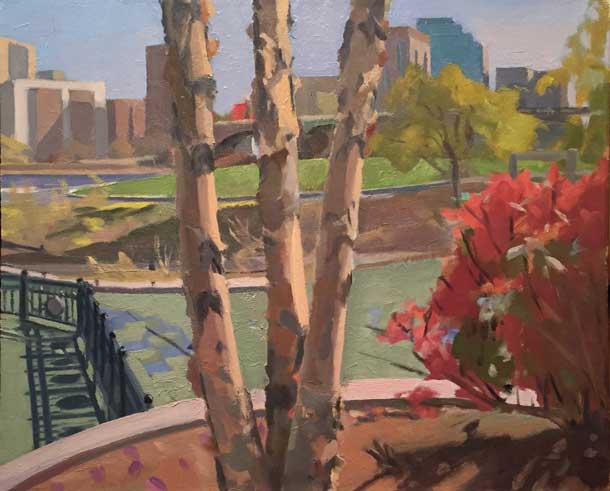
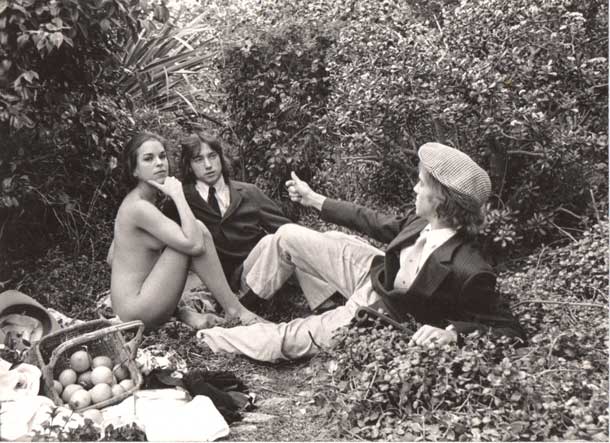
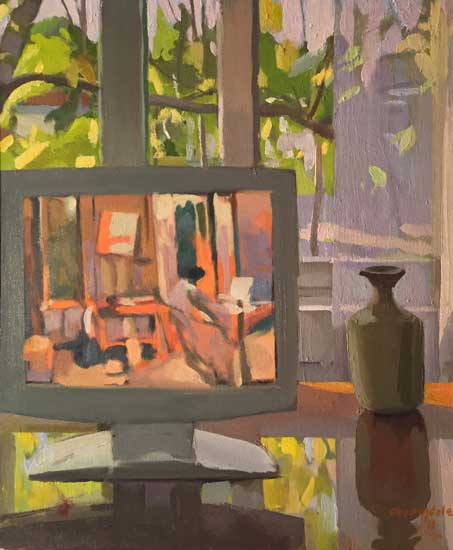
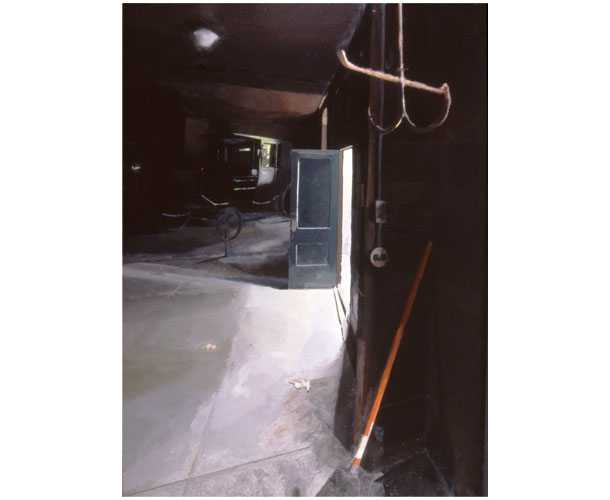
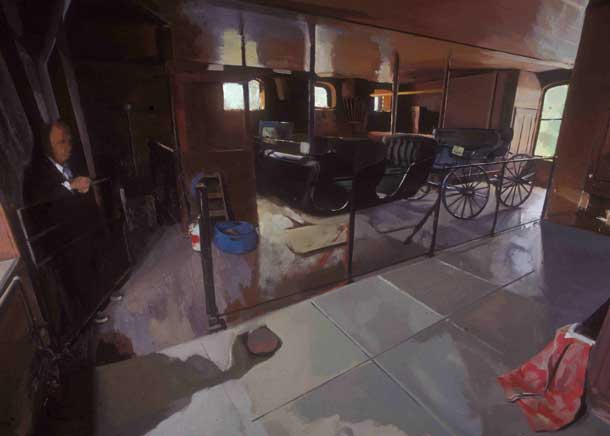
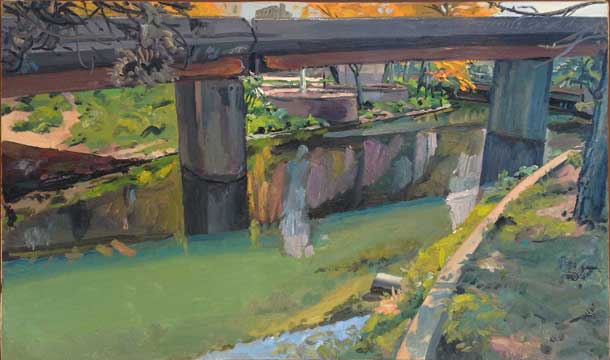
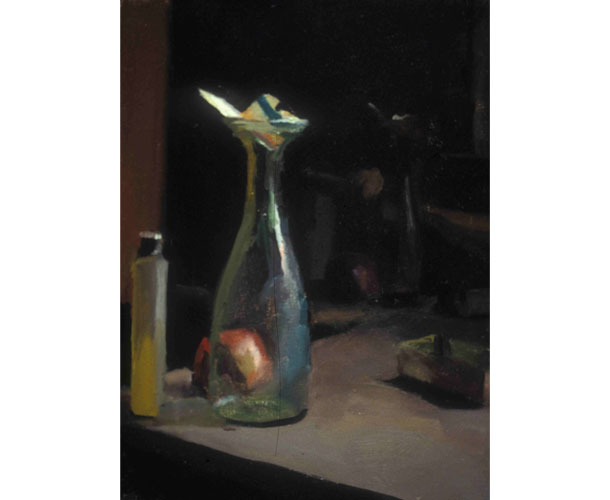
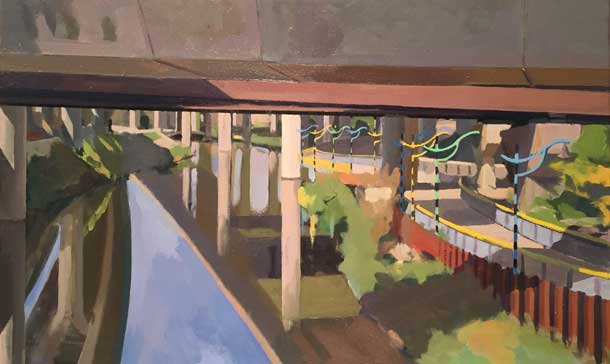
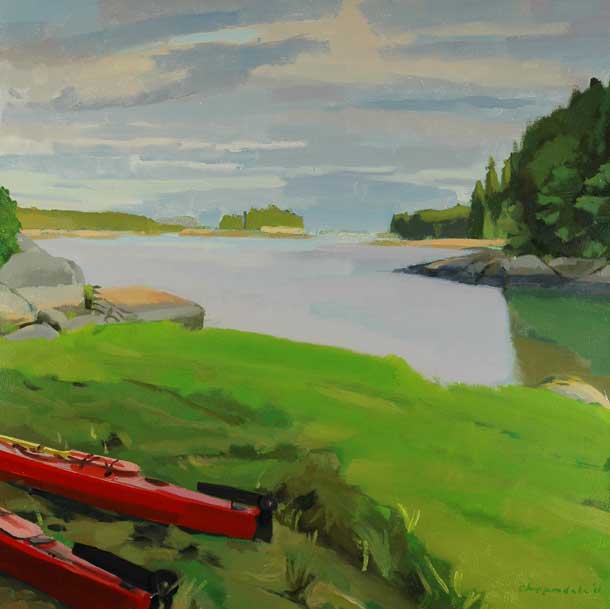
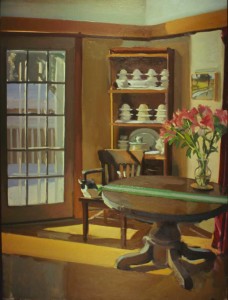
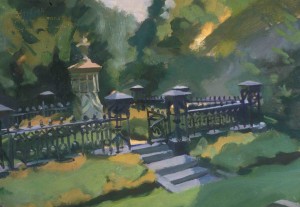
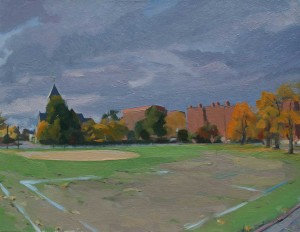
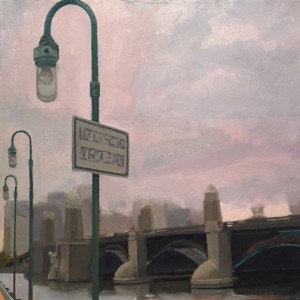
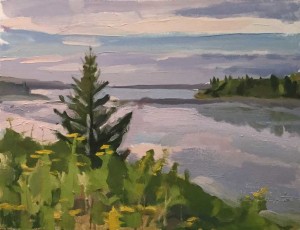
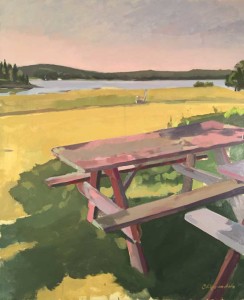
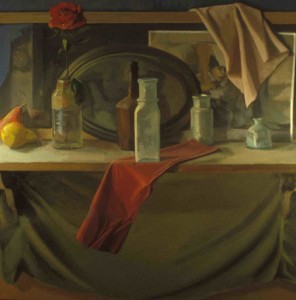

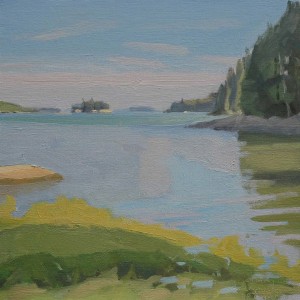
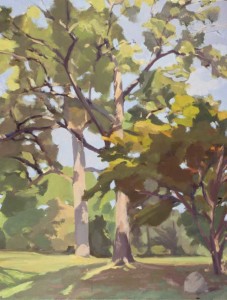
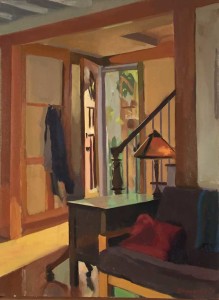
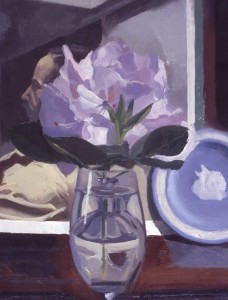

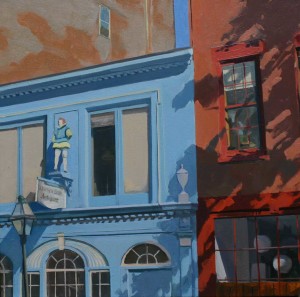




Beautiful paintings and a really interesting interview. There is so much that Christopher says that I feel in sympathy with – particularly in relation to the goal of attempting to see the world without preconception. Well done!
This is a fabulous interview with Christopher Chippendale. Not only does Chippendale provide great depth of insight about ‘the way’ of observational artists… he also gives us a story of a wonderfully rich teacher-student relationship. George Nick’s emphasis on unguarded forgetful refreshed ‘open-eyed’ daily practice as preparation for the unpredictable moments of revalation and those infrequent visits by the muse is priceless wisdom for those who wish to follow the artist way. Interwoven in Chippendale’s narrative is a philosophical treatise, convincing, in part, by its unpretensiousness.
Thank you Larry Groff for organizing, editing, and publishing these interviews with artists.
another great article…. love the interior paintings…The Carriage House, and The Sleigh, there dark setting and such depth…very captivating…
Eloquent and thoughtful… this deserves multiple readings with a highlighter. I appreciate so much whenever someone intelligently and carefully puts words to what painting is –all of the history and philosophy and expansiveness and intricacy of process that goes into what somethimes can feel rather mundane. But these complicated ideas, and the surprises, and the face-to-face encounters with unknown/unseen forces–this is what keeps us coming back. I appreciate the discussion about truth and it’s un-absoluteness, which is a difficult paradox that I find I attempt to resolve in my own head by using the word “honesty” in its place, although I’m not sure if that’s accurate. Also, lately in my own work I’ve been thinking about the ideas of vulnerability and risk, and I wonder if and how these ideas factor into the observational painter’sapproach. Thank you for all of the time and effort that went into this very valuable and thought-provoking piece!
Woah, I knew I loved Chris Chippendale’s work, but I had little idea of the background, and no idea of the amazing range and trajectory! Proud to be his colleague! Keep the work coming.
Chris Chippendale was my painting teacher at MassArt for many years. Only good things can be said about his method of instruction, insight, respect and care towards his students. A great interview of a great instructor.
Painters paint as a condition of not knowing
Amazing!
thank you
Given your having been a student of George Nick, & your interest in Edwin Dickinson, you may want to view my video on Dickinsson’s teaching, & look into the web-site of Francis (Dick) Cunningham, as he taught for many years color spot painting, & has written a 48 page paper on the subject. I mention this as Dick & I were students of E.D. at .the League in1957&58. Your work is most impressive to be sure.